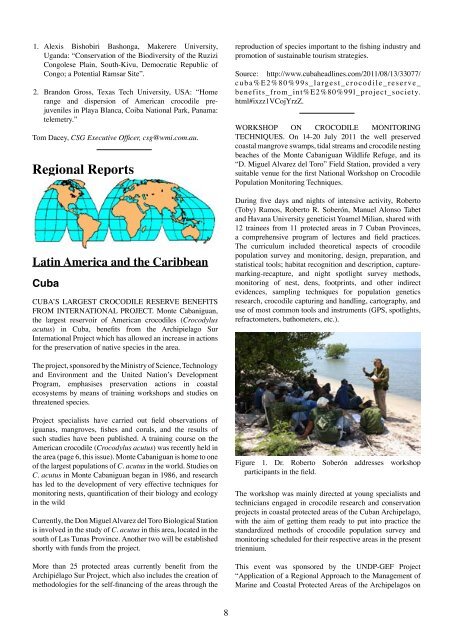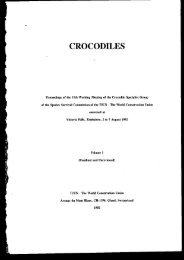size: 992KB - Crocodile Specialist Group
size: 992KB - Crocodile Specialist Group
size: 992KB - Crocodile Specialist Group
You also want an ePaper? Increase the reach of your titles
YUMPU automatically turns print PDFs into web optimized ePapers that Google loves.
1. Alexis Bishobiri Bashonga, Makerere University,<br />
Uganda: “Conservation of the Biodiversity of the Ruzizi<br />
Congolese Plain, South-Kivu, Democratic Republic of<br />
Congo; a Potential Ramsar Site”.<br />
2. Brandon Gross, Texas Tech University, USA: “Home<br />
range and dispersion of American crocodile prejuveniles<br />
in Playa Blanca, Coiba National Park, Panama:<br />
telemetry.”<br />
Tom Dacey, CSG Executive Officer, csg@wmi.com.au.<br />
Regional Reports<br />
Latin America and the Caribbean<br />
Cuba<br />
CUBA’S LARGEST CROCODILE RESERVE BENEFITS<br />
FROM INTERNATIONAL PROJECT. Monte Cabaniguan,<br />
the largest reservoir of American crocodiles (Crocodylus<br />
acutus) in Cuba, benefits from the Archipielago Sur<br />
International Project which has allowed an increase in actions<br />
for the preservation of native species in the area.<br />
reproduction of species important to the fishing industry and<br />
promotion of sustainable tourism strategies.<br />
Source: http://www.cubaheadlines.com/2011/08/13/33077/<br />
c u b a % E 2 % 8 0 % 9 9 s _ l a rg e s t _ c r o c o d i l e _ r e s e r v e _<br />
benefits_from_int%E2%80%99l_project_society.<br />
html#ixzz1VCojYrzZ.<br />
WORKSHOP ON CROCODILE MONITORING<br />
TECHNIQUES. On 14-20 July 2011 the well preserved<br />
coastal mangrove swamps, tidal streams and crocodile nesting<br />
beaches of the Monte Cabaniguan Wildlife Refuge, and its<br />
“D. Miguel Alvarez del Toro” Field Station, provided a very<br />
suitable venue for the first National Workshop on <strong>Crocodile</strong><br />
Population Monitoring Techniques.<br />
During five days and nights of intensive activity, Roberto<br />
(Toby) Ramos, Roberto R. Soberón, Manuel Alonso Tabet<br />
and Havana University geneticist Yoamel Milian, shared with<br />
12 trainees from 11 protected areas in 7 Cuban Provinces,<br />
a comprehensive program of lectures and field practices.<br />
The curriculum included theoretical aspects of crocodile<br />
population survey and monitoring, design, preparation, and<br />
statistical tools; habitat recognition and description, capturemarking-recapture,<br />
and night spotlight survey methods,<br />
monitoring of nest, dens, footprints, and other indirect<br />
evidences, sampling techniques for population genetics<br />
research, crocodile capturing and handling, cartography, and<br />
use of most common tools and instruments (GPS, spotlights,<br />
refractometers, bathometers, etc.).<br />
The project, sponsored by the Ministry of Science, Technology<br />
and Environment and the United Nation’s Development<br />
Program, emphasises preservation actions in coastal<br />
ecosystems by means of training workshops and studies on<br />
threatened species.<br />
Project specialists have carried out field observations of<br />
iguanas, mangroves, fishes and corals, and the results of<br />
such studies have been published. A training course on the<br />
American crocodile (Crocodylus acutus) was recently held in<br />
the area (page 6, this issue). Monte Cabaniguan is home to one<br />
of the largest populations of C. acutus in the world. Studies on<br />
C. acutus in Monte Cabaniguan began in 1986, and research<br />
has led to the development of very effective techniques for<br />
monitoring nests, quantification of their biology and ecology<br />
in the wild<br />
Currently, the Don Miguel Alvarez del Toro Biological Station<br />
is involved in the study of C. acutus in this area, located in the<br />
south of Las Tunas Province. Another two will be established<br />
shortly with funds from the project.<br />
More than 25 protected areas currently benefit from the<br />
Archipiélago Sur Project, which also includes the creation of<br />
methodologies for the self-financing of the areas through the<br />
Figure 1. Dr. Roberto Soberón addresses workshop<br />
participants in the field.<br />
The workshop was mainly directed at young specialists and<br />
technicians engaged in crocodile research and conservation<br />
projects in coastal protected areas of the Cuban Archipelago,<br />
with the aim of getting them ready to put into practice the<br />
standardized methods of crocodile population survey and<br />
monitoring scheduled for their respective areas in the present<br />
triennium.<br />
This event was sponsored by the UNDP-GEF Project<br />
“Application of a Regional Approach to the Management of<br />
Marine and Coastal Protected Areas of the Archipelagos on<br />
8

















